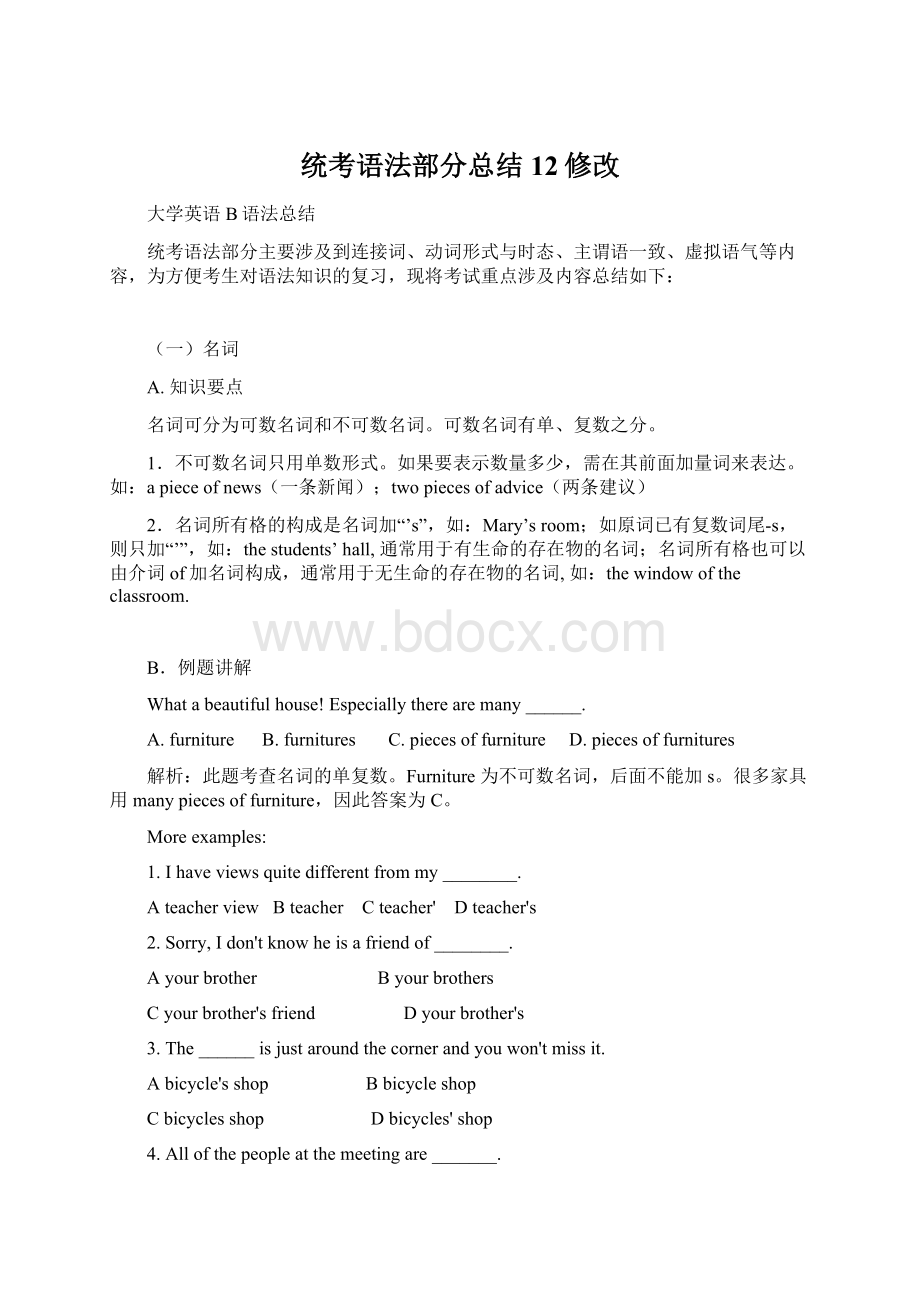统考语法部分总结12修改Word下载.docx
《统考语法部分总结12修改Word下载.docx》由会员分享,可在线阅读,更多相关《统考语法部分总结12修改Word下载.docx(27页珍藏版)》请在冰豆网上搜索。

Bteacher
Cteacher'
Dteacher'
s
2.Sorry,Idon'
tknowheisafriendof________.
Ayourbrother
Byourbrothers
Cyourbrother'
sfriend
Dyourbrother'
3.The______isjustaroundthecornerandyouwon'
tmissit.
Abicycle'
sshop
Bbicycleshop
Cbicyclesshop
Dbicycles'
shop
4.Allofthepeopleatthemeetingare_______.
Amathematicalteachers
Bmathematicteachers
Cmathematicsteachers
Dmathematic'
steachers
5.Wearenext-door_______.
Aneighborhoods
Bneighbor
Cneighborhood
Dneighbors
(二)冠词
冠词是一种虚词,用在名词前面,说明名词是特指还是泛指。
冠词分不定冠词和定冠词。
1.不定冠词:
a/an表示“一”、“某一”概念,用于单数可数名词前。
a用在辅音开头的词前,an用在元音开头的词前。
anEnglishteacher/asecondyear一位老师/又一年;
2.定冠词:
the表示“特指的一个或一些”。
通常用在形容词最高级及序数词前,或世界上独一无二的事物前;
也用于乐器名词前。
thebestseason最好的季节/thefirstlady第一夫人/theearth地球/playthepiano弹钢琴;
3.不使用冠词的情况:
在三餐饭、球类运动和娱乐运动的名称之前。
在某些惯用词中也不用冠词,以具体名词表示抽象概念。
如:
havelunch吃午饭/playbasketball打篮球/gotoschool上学
1)______girldressed______blackishersisterRose.(《大学英语》(B)Test2,34)
A.A;
in
B.A;
on
C.The;
D.The;
in
D。
介词in可表示“穿(戴)”的意思。
此外,特指“穿黑色衣服的女孩”,用定冠词the.
2)Heisfondofplaying_______pianowhilehisbrotherisinterestedinlisteningto_______music.(《大学英语》(B)Test5,36)
A./;
the
B./;
/
C.the;
D.the;
the
C。
演奏的乐器名词前+the。
Music为不可数名词,其前不用可用a/an,而题意“对音乐感兴趣”并没有特指哪种音乐,也不可用the.
3)Hegoesto______churcheverySunday.______churchheusuallygoestohasseatingforoverathousand.
A.a,the
B./,The
C.The,the
D./,a
B。
gotochurch“做礼拜”是惯用法,不用冠词。
“他常去的教堂”表特指,前加the。
1.Iearn10dollars______houras______supermarketcashieronSaturdays.
Aa…an
Bthe…a
Can…a
Dan…the
(三)代词
代词用于指代。
包括:
人称、物主、反身、疑问、不定代词等。
1.many,few和afew一般只能修饰或指代可数名词,much,little和alittle一般只能修饰或指代不可数名词。
afew和alittle表示“有一些”,具有肯定意义,而few和little表示“几乎没有”,具有否定意义。
many和much表示“许多”。
2.表示“全部”:
两者用both,三者以上用all;
表示“全无”:
两者用neither,三者以上用none;
表示“任一”:
两者用either,三者以上用any。
3.other,others,theother,theothers,another的区别
(1)other作形容词修饰名词,泛指“别的、其他的”。
有时会放在some,any,every,no等词之后。
e.g.WestudyChinese,maths,Englishandotherlessons.
(2)others是代词,泛指“其他人或物”。
I'
mgladtohelpothers.
(3)theother特指范围内的另一个(范围内一共两个)。
e.g.Ihavetwofriends.OneisfromAustralia,theotherisfromJapan.
(4)theothers特指范围内的另一些(范围总数通常多于两个)。
e.g.Therearefortystudentsinourclass.Twenty-eightofusareboys,theothersaregirls.
(5)another指同类中(三个或三个以上)的“另一个”,是指不确定的另一个。
e.g.Wouldyoulikeanothercupofcoffee?
1)Thebabyishungry,butthere’s______milkinthebottle.(《大学英语》(B)Test2,28)
A.little
B.alittle
C.few
D.afew
A。
milk是不可数名词,所以只能用little/alittle修饰,而根据题意“宝宝饿了,但瓶里几乎没有牛奶了”,只能选little。
2)Shehastwobestfriends.______ofthemisinthecountry.(《大学英语》(B)Test2,44)
A.All
B.Both
C.Noone
D.Neither
代词all表“所有”和both表“两者都”,其后的谓语动词需要用复数。
neither表“两者都不”,其后的谓语动词用单数。
3)—It’stimetotidyyourroom,Harry!
(《大学英语》(B)Test5,33)
—Seethetidyroom,Mum!
_______iswhereitshouldbe.Test5
A.Something
B.Anything
C.Everything
D.Nothing
根据说话人所说内容可以知道,房间里一切都很整洁,含有整体性,应用everything。
Anything用于肯定句时,表强调,该句没有强调之意。
4)Theredflowergoesfromoneto_______intheclass.(《大学英语》(B)Test6,27)
A.theother
B.others
C.another
D.other
按照句意传花不是两者之间(fromonetotheother),而是三者以上(fromonetoanother),故选C。
1.Heopenedtheletteranditcontained________.
Aanimportantinformation
Bsomeimportantinformations
Cmanyimportantinformation
Dsomeimportantinformation
2.-Fortonight'
shomework,dopages40and41intheworkbook..
-ProfessorHones,Ithinkthatis________work.
Atoomuch
Bmuchthemore
Ctoohard
Dhardest
3.Chinaisawonderfulplaceandthereis_______toseeandenjoy.
Aalotof
Bmany
Cmuch
Dmanymore
4.Wouldyoulikesomemorecoffee?
There'
sstill______left.
Aalittle
Blittle
Cafew
Dfew
5.Theboyisnothappyatthenewschool.Hehas________friendsthere.
Afew
Bafew
Clittle
Dalittle
6.Hiswordsare________butthemeaningisdeep.
Bafew
7.Englandisanislandcountry.________consistsofthreeprincipalislands,and________climateisgenerallymild.
AIt…its
BShe…her
CHe…his
DShe…its
(四)数词
数词分为两大类:
基数词和序数词。
1.基数次表示数量(one,two,three…),序数次表示次序(first,second,third…)。
2.数词hundred,thousand,million不用复数;
其“复数+of”可表示上百、成千、数百万,如:
threethousand三千/thousandsoftrees(成千上万的树)
3.在年龄的表达时,注意以下表达法:
Heissixyearsold.(其中year须用其复数)
Heisasix-year-oldboy.(其中year不用复数)“他6岁了。
”
1)Theyhavelearnedabout______inrecentyears.(《大学英语》(B)Test2,37)
A.severalhundredsEnglishwords
B.hundredsofEnglishwords
C.hundredofEnglishwords
D.severalhundredEnglishword
hundredsof之类的短语之前也可加many,several之类的词修饰。
A项的错误在于hundreds后缺少of。
2)Nancyis______girl.(《大学英语》(B)Test2,29)
A.aeighteen-year-old
B.aneighteen-years-old
C.aeighteen-years-old
D.aneighteen-year-old
eighteen-year-old是一个由连字符连接的复合形容词(其中year不用复数),作girl的定语。
同时,由于eighteen是元音开头的词,前面的不定冠词用an。
(五)形容词和副词的比较级与最高级
形容词和副词的应用
(1)同等程度比较:
as+原级+as
e.g.TomisasbrightasMark.汤姆和亨利一样聪明。
(2)不同程度的比较:
比较级+than
e.g.TomistallerthanMark.汤姆比亨利高。
notas/so+原级+as
e.g.Tomisnotas/sobrightasMark.汤姆不如亨利聪明。
(3)对比与比较:
the+比较级,the+比较级e.g.TheolderIget,thehappierIam.我越变老,越觉得幸福。
比较级+and+比较级
e.g.Janebecamemoreandmorebeautiful.珍妮越来越漂亮了。
(4)当几个形容词修饰一个名词时,其排列顺序是:
好坏、美丑+大小、新旧、颜色+质地、属性+名词
(5)当被修饰的是以-thing,-one,-body结尾的不定代词时,作定语的形容词要后置。
e.g.Ireadsomethinginteresting.我读了一些有趣的东西。
例题讲解
1)Yourboxis
mine.
A.fourtimesasbigas
B.fourtimesasbiggeras
C.asfourtimesbig
D.asbigasfourtimes
在as…as句型中,如有表示程度的状语(如twice,threetimes),则置第一个as之前,表示前者是后者的几倍。
2)Today’sweatheris______worsethanyesterday’s.(《大学英语》(B)Test2,40)
A.very
B.much
C.verymuch
D.muchtoo
very用来修饰形容词的原级形式;
much修饰比较级;
verymuch一般用来修饰动词;
muchtoo常用来修饰形容词的原级形式。
3)—Didthemedicinemakeyoufeelbetter?
(《大学英语》(B)Test6,43)
—No.Themore_______,_______Ifeel.
A.medicineItake;
andtheworse
B.medicineItake;
theworse
C.Itakemedicine;
theworse
D.Itakemedicine;
worse
本题是“越…越…”句型,要用“the+比较级,the+比较级”句型,前后分句都用陈述语气。
4)—Whatwillyoubuyforyourboyfriend’sbirthday?
(《大学英语》(B)Test5,34)
—Iwanttobuya_______walletforhim.
A.blackleathersmall
B.smallblackleather
C.smallleatherblack
D.blacksmallleather
根据多个形容词作定语次序排列规律,应该是small(大小)+black(颜色)+leather(质地)。
(六)动词的基本时态
1.一般现在时态
形式为do或does(第三人称单数)。
e.g.Theearthmovesaroundthesun.地球绕着太阳转。
Healwaysgoestoschoolbybike.他总是骑车去上学。
(特别提醒:
.一般现在时可以代替将来时,用于时间和条件状语从句中。
)
e.g.Pleasebesuretotelephonemethenexttimeyoucome.下次来之前请一定给我来电话。
2.一般过去时态
形式为did.
e.g.Iboughtthiscomputerfiveyearsago.
Heoftentookawalkaftersupperwhenhewasalive.
3.一般将来时态
形式为will/shalldo/begoingtodo.
e.g.Thetelephoneisringing.Iwillanswerit.电话在响,我去接。
4.现在进行时态
形式为is/am/are+doing,表示此时此刻或现阶段正在进行的动作。
e.g.Thepolicearelookingforthetwomissingchildren.警察们正在寻找两个丢失的孩子。
5.过去进行时态
形式为was/were+doing,表示过去某个时刻正在进行的动作。
e.g.Janeburntherhandwhenshewascookingthedinner.
6.现在完成时态
形式为have/hasdone,常与already,never,ever,yet连用。
用来表示过去发生的对现在有影响的动作。
e.g.Themilkhasalreadybecomeundrinkable牛奶已经不能喝了。
或者表示过去某时间开始一直延续到现在的动作。
e.g.Hehaslivedheresince1949.自从1949年以来,他一直住在这儿。
7.过去完成时
形式为haddone.表示在过去某一时刻以前已经开始并一直延续到这一时刻、或是在此刻前已经完成的动作。
e.g.Bytheendoflasttermwehadlearned1000Englishwords.到上学期末我们已经学了1000个英语单词。
1)WhenLilycamehomeat5p.m.yesterday,hermother______dinnerinthekitchen.(《大学英语》(B)Test1,36)
A.cooked
B.wascooking
C.cooks
D.hascooked
2)John’sfather______mathematicsinthisschooleversincehegraduatedfromHarvardUniversity.(《大学英语》(B)Test1,40)
A.taught
B.teaches
C.hastaught
D.isteaching
3)Iwasgivingatalktoalargegroupofpeople,thesametalkI______tohalfadozenothergroupsbefore.(《大学英语》(B)Test2,45)
A.wasgiving
B.amgiving
C.hadgiven
D.havegiven
更多实例:
一、过去时态
1.He______tomelastweek.
Aiswriting
Bwrites
Cwrote
Diswritten
2.Alongtimeago,I_______inLondonforthreeyears.
Ahadlived
Bhaveli